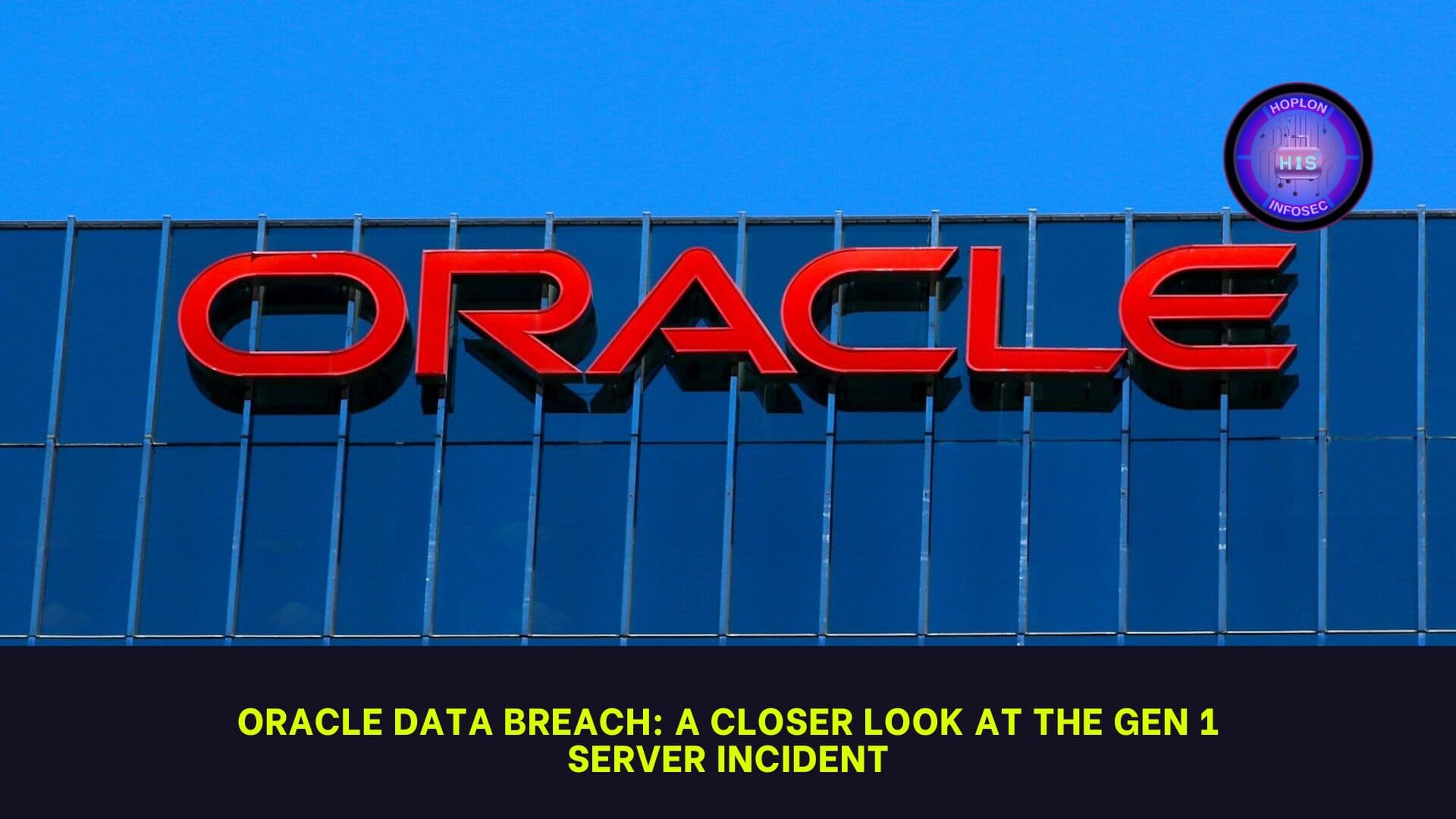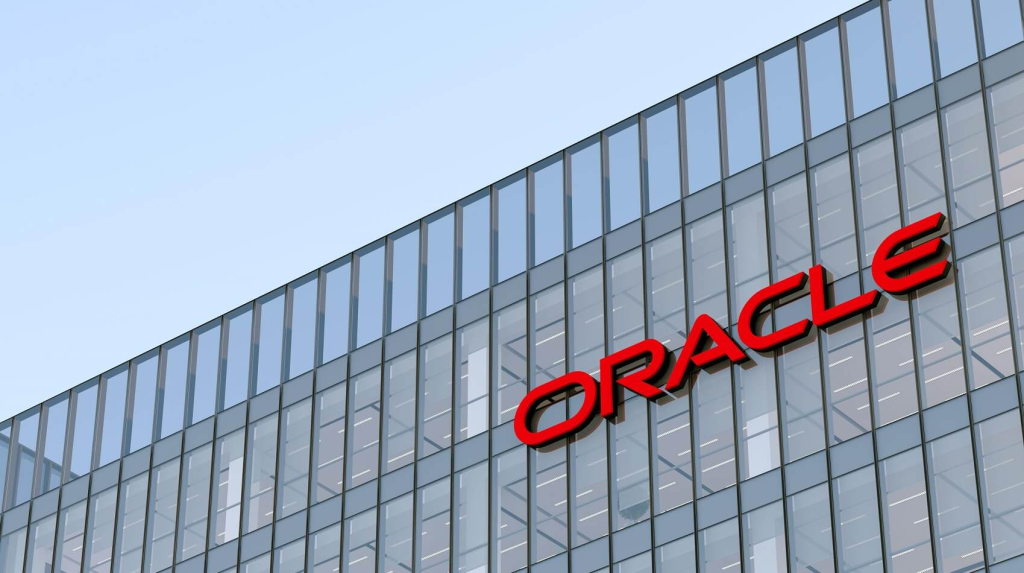Oracle Data Breach: A Closer Look at the Gen 1 Server Incident

Hoplon InfoSec
03 Apr, 2025
Oracle Corporation recently confirmed a data breach involving its older Generation 1 (Gen 1) servers. This incident marks the second cybersecurity event disclosed by the tech giant in recent weeks. In this blog post, we delve into the details of the breach, its potential implications for enterprise security, and best practices to mitigate such risks.
Overview of the Oracle Data Breach

On March 20, 2025, a threat actor, using the pseudonym “rose87168,” claimed responsibility for the attack on Oracle’s legacy Gen 1 servers. According to the initial report posted on Breachforums, the attacker managed to access approximately 6 million data records. Although the compromised records primarily include usernames, email addresses, hashed passwords, and certain authentication credentials, the breach has raised broader concerns about the security measures in place for Oracle’s older systems.
Oracle has verified that while the exposed data does not include complete Personally Identifiable Information (PII), it does involve sensitive authentication details such as Single Sign-On (SSO) and Lightweight Directory Access Protocol (LDAP) information. In addition, the attacker exfiltrated Java Key Store (JKS) files and Enterprise Manager JPS keys, which are crucial for maintaining secure communications and system integrity.
Background on Legacy Systems and Security Challenges
Understanding Gen 1 Servers
Oracle’s Gen 1 servers represent older infrastructure that, although reliable in their time, are now facing challenges in keeping up with modern cybersecurity threats. These legacy systems were designed in an era when cyber threats were far less sophisticated. As organizations have rapidly adopted cloud technologies, these older servers often become vulnerable entry points if not updated or fully integrated into newer security frameworks.
The Importance of Regular Updates and Migration
Legacy systems, such as Oracle’s Gen 1 servers, may not receive the same level of regular security patches and updates as modern systems. This gap leaves them susceptible to exploits that take advantage of outdated protocols and software vulnerabilities. In the case of Oracle, the breach was facilitated by a Java exploit dating back to 2020. This vulnerability enabled the attacker to deploy a web shell and malware, ultimately targeting Oracle’s Identity Manager (IDM) database.
How the Breach Unfolded
Initial Access and Exploitation
Security analysts have determined that the attacker, “rose87168,” may have gained access to Oracle’s legacy systems as early as January 2025. The breach remained undetected until late February when Oracle initiated an internal investigation. The prolonged undetected period provided the attacker ample time to move laterally within the network and exfiltrate sensitive data.
The exploitation process involved a known vulnerability in Java, a programming language and platform widely used in enterprise applications. By leveraging this vulnerability, the attacker could bypass certain security measures and install malicious software. The use of a web shell—a remote access tool that gives attackers control over a compromised system—was critical in facilitating ongoing access to Oracle’s legacy systems.
Types of Data Compromised
The data stolen in the breach encompasses multiple categories:
- User Credentials: Usernames and email addresses were among the compromised records.
- Authentication Details: Hashed passwords, along with SSO and LDAP credentials, were exposed.
- Security Keys and Certificates: The attacker exfiltrated critical files, such as Java Key Store (JKS) files and Enterprise Manager JPS keys, which are instrumental in managing encryption and secure communication within Oracle’s network.
Although Oracle confirmed that the compromised data was approximately 16 months old and did not contain complete PII, the breach still represents a significant risk, especially if similar tactics are used in future attacks targeting more current systems.
Analysis of the Threat Actor

Profile of “rose87168”
The individual behind this breach, operating under the handle “rose87168,” appears to be a relatively new entrant in the cybercrime landscape. The account used by the threat actor was reportedly created in March 2025, suggesting that the actor might be either an emerging criminal or a new team member within a larger criminal organization. The primary motive appears to be financial, as indicated by the subsequent ransom demand of $20 million directed at Oracle.
Criminal Ambitions and Data Exchange Tactics
Beyond financial extortion, “rose87168” has hinted at broader criminal ambitions. In communications following the breach, the actor expressed willingness to trade the stolen data for zero-day exploits—previously unknown vulnerabilities that can be exploited before a fix is available. This dual approach of demanding ransom and offering to exchange critical information for further exploitation underscores a shift in tactics within the cybercrime community, where data is used as both a bargaining chip and a commodity.
Verification and Validation of Stolen Data
The credibility of the breach was further supported when the threat actor released sample data, including portions of the LDAP credentials and sample databases. Prominent security researcher Kevin Beaumont confirmed that data shared with a journalist left little doubt about the occurrence of the breach. Such third-party validation is crucial, as it underscores the severity of the attack and the real risk it poses to enterprise security.
Implications for Enterprise Security
Risks Posed by Legacy Systems
The Oracle Gen 1 server breach is a stark reminder of the vulnerabilities inherent in legacy systems. Even well-established companies can face significant risks if older infrastructure is not adequately maintained or integrated with modern security protocols. As cyber threats continue to evolve, legacy systems can serve as weak links, potentially exposing broader segments of an organization’s digital environment to attacks.
Impact on Supply Chain and Client Trust
Large enterprises like Oracle have extensive networks of clients and partners. A breach in one part of the system, especially one that handles sensitive authentication data, can have cascading effects on the security posture of connected systems. Clients whose data has been compromised may face increased risks of phishing, identity theft, and further cyberattacks. As a result, maintaining robust security across all systems, old and new, is critical for preserving client trust and ensuring overall network security.
Challenges in Securing Mixed Infrastructures
Oracle’s incident highlights the complex challenge of managing and securing a mixed infrastructure. While the company has stated that its Generation 2 (Gen 2) servers and primary Oracle Cloud infrastructure remain unaffected, the fact that older systems were compromised emphasizes the need for a comprehensive security strategy. It is not enough to secure the latest platforms; organizations must also address vulnerabilities in legacy systems to prevent attackers from exploiting these entry points.
Oracle’s Response and Mitigation Measures
Immediate Remediation Efforts
Following the detection of the breach in late February 2025, Oracle swiftly initiated an internal investigation. Affected clients were notified, and security measures were immediately reinforced around the compromised Gen 1 servers. Oracle has reassured stakeholders by emphasizing that their more modern Gen 2 servers, as well as the core Oracle Cloud infrastructure, have not been compromised.
Enhancing Security Protocols
In response to the breach, Oracle is expected to take several steps to bolster its cybersecurity defenses. These steps include:
- Resetting Credentials: Affected clients have been advised to reset their passwords and update security credentials to mitigate the risk of further unauthorized access.
- Monitoring for Suspicious Activity: Organizations are urged to maintain vigilant monitoring of network activity to detect any unusual behavior that may indicate further exploitation attempts.
- Upgrading Legacy Systems: One of the most effective long-term strategies involves migrating legacy systems to more secure, modern platforms. This migration helps close off vulnerabilities that attackers can exploit.
Communication with Stakeholders
Oracle’s response included detailed communication with stakeholders, including internal teams and affected clients. While the company publicly denied any breach of its primary cloud infrastructure, cybersecurity firm CybelAngel later reported that Oracle had privately acknowledged the incident to a select group of stakeholders. This dual approach—public reassurance combined with targeted internal communication—reflects the challenges large enterprises face in balancing transparency with security concerns.
Expert Perspectives on the Breach
Commentary from Cybersecurity Experts
The Oracle Gen 1 server breach has drawn significant attention from cybersecurity professionals worldwide. Experts point out that incidents like this one serve as a wake-up call for all organizations, not just those in the tech sector. Cybersecurity expert Kevin Beaumont commented on the breach, noting that the release of the sample data provided indisputable evidence of a significant cybersecurity incident. Such expert validations reinforce the need for ongoing vigilance in the ever-evolving landscape of cyber threats.
Lessons Learned from the Incident
This breach reinforces several key lessons for organizations managing legacy systems:
- Regularly Update and Patch Systems: Outdated software and systems are prime targets for cyberattacks. Organizations must ensure that all systems, regardless of age, receive regular updates and patches.
- Adopt a Comprehensive Security Strategy: Security measures should extend beyond new systems. A holistic approach that includes legacy systems is essential.
- Invest in Modern Security Tools: Advanced security tools that can detect and mitigate emerging threats are vital. Integrating these tools into older systems can help bridge the security gap until those systems are fully replaced.
- Employee Awareness and Training: Often, the human element is the weakest link in cybersecurity. Regular training and awareness programs can help employees identify and avoid potential threats.
The Broader Context: Cybersecurity Trends
The Evolution of Cyber Threats
Over the past decade, cyber threats have evolved significantly. Attackers are now more sophisticated, using advanced tools and techniques to breach even well-defended networks. The use of zero-day exploits, like the one that facilitated the Oracle breach, demonstrates the ongoing arms race between cybercriminals and security professionals. Zero-day vulnerabilities are particularly dangerous because they represent unknown weaknesses that software vendors have not yet addressed.
Financial Motives and Ransom Demands
The financial motives behind modern cyberattacks have also changed. While early cybercrimes were often motivated by a desire to cause disruption or gain notoriety, many contemporary attacks are driven by profit. The $20 million ransom demand made by “rose87168” highlights the trend of financially motivated cyber extortion. In addition, the willingness to trade stolen data for zero-day exploits shows that data breaches are increasingly being used as leverage for further criminal activities.
The Role of Public Disclosure
Public disclosure of data breaches plays a critical role in modern cybersecurity. By bringing breaches to light, companies can work together with cybersecurity researchers, law enforcement, and other stakeholders to address vulnerabilities and prevent future incidents. However, public disclosures also raise concerns about the potential for further exploitation if sensitive details are revealed. Oracle’s case is a prime example of the balancing act companies must perform when addressing security breaches: they need to inform affected parties and mitigate risks while also preventing additional exploitation.
How Organizations Can Protect Themselves
Strengthening Legacy Systems
For organizations still operating legacy systems, the Oracle incident serves as an important lesson. Companies should consider the following measures to secure older systems:
- Conduct Comprehensive Security Audits: Regularly audit all systems to identify vulnerabilities and prioritize necessary upgrades.
- Isolate Legacy Systems: Where possible, isolate older systems from critical network infrastructure to reduce the risk of lateral movement by attackers.
- Implement Multi-Factor Authentication: Adding layers of authentication can help protect systems even if credentials are compromised.
- Apply Virtual Patching: In cases where physical updates are not feasible, virtual patching can provide temporary protection against known vulnerabilities.
Enhancing Organizational Cyber Resilience
Cyber resilience is about more than just preventing breaches—it is about ensuring that an organization can quickly detect, respond to, and recover from cybersecurity incidents. This involves:
- Developing a Robust Incident Response Plan: Having a clear, well-tested incident response plan can make a significant difference in minimizing the impact of an attack.
- Investing in Continuous Monitoring: Advanced monitoring tools can detect unusual activity early, allowing for faster response times.
- Regular Employee Training: Ensuring that all employees understand the basics of cybersecurity can reduce the risk of social engineering attacks and other human-related vulnerabilities.
Collaborative Efforts in Cybersecurity
The battle against cybercrime is not one that organizations can fight alone. Collaboration between companies, cybersecurity experts, and law enforcement agencies is essential. Information sharing about threats and vulnerabilities helps build a stronger, more resilient digital infrastructure. Oracle’s proactive communication with stakeholders following the breach is an example of how transparency can facilitate a more coordinated response to cybersecurity threats.
Moving Forward: Lessons for the Future
Embracing a Proactive Security Culture
The Oracle Gen 1 server breach underscores the need for a proactive security culture within organizations. Rather than waiting for an attack to occur, companies must continuously invest in upgrading their systems and reinforcing their security protocols. This proactive stance includes:
- Regularly Reviewing Security Policies: Security policies should evolve in tandem with the threat landscape.
- Embracing New Technologies: Leveraging emerging technologies like artificial intelligence for threat detection can offer a competitive edge in cybersecurity.
- Fostering a Culture of Cyber Awareness: Every employee, from entry-level to executive, should understand their role in maintaining cybersecurity.
The Imperative of Digital Transformation
For many organizations, the challenge of managing legacy systems is part of a broader need for digital transformation. Migrating to modern cloud infrastructures not only provides better performance and scalability but also enhances security by integrating the latest defense mechanisms. Oracle’s assurance that its Gen 2 servers and primary cloud infrastructure remain unaffected highlights the benefits of digital transformation. However, the incident serves as a reminder that this transformation must be comprehensive and include the decommissioning or upgrading of older systems.
Final Thoughts
The recent Oracle breach involving Gen 1 servers is a cautionary tale for all organizations. It emphasizes that even industry leaders are not immune to the evolving threats posed by sophisticated cybercriminals. Legacy systems, while once state-of-the-art, can become significant vulnerabilities if not properly maintained or upgraded. The incident underlines the importance of a proactive, holistic approach to cybersecurity that spans both modern and legacy infrastructures.
As Oracle works to reinforce its defenses and restore stakeholder confidence, organizations worldwide are reminded to conduct thorough audits, isolate vulnerable systems, and invest in both technological and cultural shifts toward robust cybersecurity. With cyber threats showing no signs of abating, the lessons learned from this breach are both timely and essential for anyone responsible for protecting digital assets.
Practical Steps for Enhanced Cybersecurity
Reviewing and Updating Security Infrastructure
In the wake of this breach, organizations should evaluate their current security infrastructure comprehensively. This evaluation should include an assessment of all systems—new and legacy—to identify any potential vulnerabilities. By taking a methodical approach to security audits, companies can preemptively address weaknesses before cybercriminals exploit them.
Engaging with Cybersecurity Experts
Organizations are encouraged to work closely with cybersecurity professionals to understand the latest threats and mitigation strategies. Expert consultations, combined with continuous education for in-house IT teams, can make a significant difference in preventing future breaches. As demonstrated by the expert commentary following the Oracle breach, validation and external insights can help build a more resilient security posture.
Building a Culture of Continuous Improvement
Finally, fostering an environment of continuous improvement in cybersecurity practices is vital. Regular training sessions, simulated breach scenarios, and investments in cutting-edge security tools are all critical components of a strategy that can withstand the rapid evolution of cyber threats.
Conclusion
The Oracle Gen 1 server breach is a wake-up call for businesses around the globe. It serves as a reminder that no organization is too big or too advanced to be immune to cyberattacks, particularly when legacy systems are involved. By learning from this incident, organizations can better prepare themselves against future threats, ensuring that both old and new systems are fortified against potential breaches.
In summary, this comprehensive analysis of the Oracle breach underscores the following key takeaways:
- Legacy systems can be a significant vulnerability if not regularly updated or integrated into modern security frameworks.
- Cyber attackers are increasingly sophisticated, using financial leverage and zero-day exploits as part of their toolset.
- A proactive approach to cybersecurity, involving regular audits, modernization of infrastructure, and continuous training, is essential for safeguarding sensitive data.
- Collaboration between industry experts, internal teams, and external stakeholders is crucial for building a robust and resilient defense mechanism.
As organizations continue to navigate the complexities of the modern digital landscape, the lessons from the Oracle incident will undoubtedly shape future strategies for mitigating risk and enhancing cybersecurity resilience. Maintaining vigilance, investing in technology, and fostering a culture of security are not just best practices—they are imperatives in an era where cyber threats continue to evolve at an unprecedented pace.
Source: Cybersecurity news
Share this :